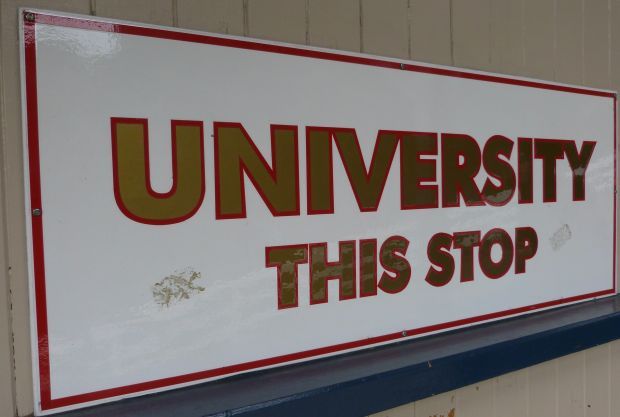Insight for Sunday 10 August 2014
Claims Tertiary Funding Damaging Learning
 by RNZ Education Correspondent, John Gerritsen @RNZeducation
by RNZ Education Correspondent, John Gerritsen @RNZeducation
The days when tertiary institutions received government funding for every student who turned up and enrolled are long gone.
Insight has been visiting universities and polytechs to gauge the effect of the government's stricter rules..

Students at a landscape lecture at Unitec in Auckland. Photo: RNZ / John Gerritsen
Enrolments are now strictly limited as a result of changes that followed unexpected, and costly, spikes in enrolments in courses of little apparent educational value in the early 2000s.
The worst performers in each sector - universities, polytechnics, private providers and wananga - can be docked up to 5 percent of their government funding.
Individual courses that fail to meet minimum completion rates - 60 percent in universities, 45 percent in polytechnics and wananga - can lose their funding altogether. (The target for private providers is 70 percent, but it is measured as an average across all their courses.)
And institutions that fall more than 1 percent short of the enrolments for which the Tertiary Education Commission has funded them, have to repay the difference.

Stop for Victoria University on Wellington's Cable Car.
Photo: RNZ / John Gerritsen
This year those measures resulted in claw-backs totalling $20.5 million - $15.8 million for under-enrolment, $2.79 million from institutions with particularly poor overall results, and $1.9 million from courses that failed to meet the completion rate benchmark.
The amounts are relatively trivial compared to the $2.7 billion that will be spent directly on government subsidies for tertiary institutions this year.
But the Minister of Tertiary Education, Steven Joyce, says the system of performance measures and sanctions is having a positive effect.
"What we're seeing is more people achieving more quickly," he says.
"The signals we're sending to the institutions, those things have seen a big focus on the sort of pastoral care and support, which has been talked about over the years, but perhaps not delivered in the way and to the extent it is being delivered now."
That argument is supported by the figures.
From 2009 to 2012, average course completion rates have risen in every sector.
They have increased from:
- 84 percent to 86 percent in universities
- 74 to 79 percent in polytechnics
- 75 to 81 percent in wananga
- 77 to 81 percent in the private sector.
Performance Figures
University and polytechnic leaders agree it is useful to publish and compare institutions' performance figures.
But they contend that the financial sanctions are unnecessary because it is enough to publicly compare results.
And they also have problems with the measures themselves.

The chief executive of Unitec, Rick Eade, says there are issues with the way qualification completion rates are measured.
Photo: RNZ / John Gerritsen
The chief executive of Unitec, Rick Ede, says the measurement of qualification completion rates is done in such a way that it is easily skewed by dips and surges in enrolments. Grow your student numbers, he says, and your qualification completion rate falls.
"Qualification completions only account probably for about a quarter of what the indicator really measures. And even though the TEC will acknowledge that, yep, there are flaws in the indicator, they have simply kept on applying it, and what that has done I believe is incentivise some games-playing around the system," he says.
And the vice-chancellor of Auckland University of Technology, Derek McCormack, says another of the measures, the course completion rate, should not be applied to individual courses.
He says some courses simply are difficult, particularly first-year maths and science papers that are prerequisites for disciplines inculding health, the sciences, and engineering.
"If you've come out of school and you want to get into some areas of technology and your maths wasn't up to scratch, well you might have a couple of goes at getting your early maths papers," he says.
"To just drop the funding for those papers seems to be a little bit scatter-gun in thinking about a well-structured, comprehensive delivery of educational programmes."

The vice-chancellor of Auckland University of Technology, Derek McCormack, thinks course completion rates shouldn't be applied to individual papers.
Photo: RNZ / John Gerritsen
Derek McCormack says the Tertiary Education Commission should leave it up to institutions to make decisions about individual courses, and restrict its monitoring to average course completion rates.
Both Rick Ede and Derek McCormack agree that some institutions might be tempted to work the system in order to improve their results in the various performance indicators. Making courses easier to pass, for example, or refusing to enrol students with a poor academic track record. But they doubt it is happening.
The president of the Tertiary Education Union, Lesley Francey, however, says it is.
"I have been told by members they have been pressured to pass students that perhaps would be very borderline," she says.
And the executive director of the Union of Students Associations, Alistair Shaw, says institutions are refusing to enrol people they fear will drag down their completion rate figures.
"People who come from alternative pathways because they're older, or they haven't completed university entrance and they need to complete some sort of bridging programme - those have been cut away because the institutions are worried that they need achieve such great completion rates and they just are focused on the students who they think won't need any support."
Such complaints show there are clear dangers in the system of tertiary education performance measures and sanctions.
The government, however, is confident it is managing those risks. The number of Maori and Pasifika students is steadily increasing, and quality assurance bodies are checking that standards are maintained.
And despite minimal increases in per-student funding, more students are completing their studies.